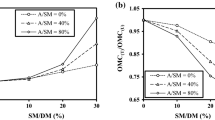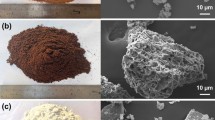Abstract
The recycling of industrial waste clays for production of an interesting ceramic product is the main goal of the present research work. Ceramic bodies were prepared using Feeders or Cyclons waste clays, sand and feldspar. 0.0, 15, 20, and 25 wt.% of sand were added at the expanse of kaolin (75-50 wt.%). Constant mass percent (25 wt.%) of feldspar was added for all ceramic compositions. The designed batches were sintered at 1200–1400 °C. Physical properties were determined by water displacement method. Phase composition and microstructure were investigated by x-ray diffraction and scanning electron microscope, respectively. The compressive strength was also determined. The results indicated that the ceramic bodies prepared from Cyclons’ waste clay exhibited higher physical and mechanical properties than that prepared from Feeders’ clay after sintering at 1400 °C. The addition of sand enhances the porosity, water absorption, bulk density and mechanical strength after sintering at 1400 °C due to the formation of mullite network and glassy phases.
Similar content being viewed by others
References
Sadek HEH, Khattab RM, Zawrah MF (2016) Preparation of porous forsterite ceramic using waste silica fumes by the starch consolidation method. Interceram 65(4):174–178
Zawrah MF, Mohammed A, Taha HAM (2018) In-situ formation of Al2O3/Al core-shell from waste material: production of porous composite improved by graphene. Ceram Int 44(9):10693–10699
Khattab RM, El-Rafei A, Zawrah MF (2012) In-situ formation of sintered cordierite-mullite nano-micro composites by utilizing of waste silica fume. Mater Res Bull 47(9):2662–2667
Zawrah MF, Gado RA, Feltin N, Ducourtieux S, Devoille L (2016) Recycling and utilization assessment of waste fired clay bricks (Grog) with granulated blast-furnace slag for geopolymer production. Process Saf Environ Prot 103(Part A):237–251
Suri J, Shaw LL, Zawrah MF (2011) Tailoring the relative Si3N4 and SiC contents in Si3N4/SiC nanopowders through carbothermic reduction and nitridation of silica fume. Int J Appl Ceram Technol:1–13. https://doi.org/10.1111/j.1744-7402.2011.00710.x
Zawrah MF, Zayed MA, Ali MRK (2012) Synthesis and characterization of SiC and SiC/Si3N4 composite nano powders from waste material. Journal of Hazardous Materials 227–228(15):250–256
Suri J, Shaw LL, Zawrah MF (2011) Synthesis of carbon-free Si3N4/SiC nanopowders using silica fume. Ceram Int 37:3477–3487
Zawrah MF, Khalil NM (2002) Utilization of Egyptian industrial-waste materials in manufacturing of refractory cement. Br Ceram Trans 101(5):225–228
Taha MA, Nassar AH, Zawrah MF (2017) Improvement of wettability, sinterability, mechanical and electrical properties of Al2O3-Ni nanocomposites prepared by mechanical alloying. Ceram Int 43:3576–3582
Haldar MK, DAS SK (2012) Effect of substitution of sand stone dust for quartz and clay in tri-axial porcelain composition. Bull Mater Sci 35(5):897–904 © Indian Academy of Sciences
Sane SC, Cook RL (1951) Effect of grinding and firing temperature on the crystalline and glass content and the physical properties of white ware bodies. J Am Ceram Soc 34(5):145–151
Mattyasovsky LZ (1957) Mechanical strength of porcelain. J Am Ceram Soc 40:299–306
Kingery WD (1976) Introduction of ceramics. Wiley, New York
Hamano K, Nakagawa Z, Hasegawa M (1992) Improvement of mechanical strength of porcelain bodies by fine grinding of raw materials. J Ceram Soc Jpn 100(8):1066–1069
Maity S, Sarkar BK (1996) Development of high-strength white ware bodies. J Eur Ceram Soc 16:1083–1088
Goel G, Kalamdhad AS (2018) Degraded municipal solid waste as partial substitute for manufacturing fired bricks. Constr Build Mater 155:259–266
Goel G, Kalamdhad AS (2017) An investigation on use of paper mill sludge in brick manufacturing. Constr Build Mater 148:334–343
Goel G, Kalamdhad AS (2018) A practical proposal for utilization of water hyacinth: recycling in fired bricks. J Clean Prod 190:261–271
Goel G, Kalamdhad AS (2018) Parameter optimization for producing fired bricks using organic solid wastes. J Clean Prod 205:836–844
Zawrah MF, El M (2007) Utilization of rice straw ash in production of advanced porous ceramics composites. Interceram 56(4):250–255
Dana K, Das SK (2004) Partial substitution of feldspar by blast furnace slag in tri-axial porcelain: phase and microstructural evolution. J Eur Ceram Soc 24:3833–3839
Dana K, Das S, Das SK (2004) Effect of substitution of fly ash for quartz in tri-axial kaolin–quartz–feldspar system. J Eur Ceram Soc 24:3169–3175
Zawrah MF, Khattab RM, Gado RA (2018) Organo modified Nanoclay/sawdust mixtures for hydrocarbon removal from water. Silicon 10(5):2055–2062
P. Wilberforce, Assessment of ceramic raw materials in Uganda for electrical porcelain, MSc Thesis, Sweden (2006)
Klien G (2001) Application of feldspar raw materials in the silicate ceramic industry. Inter Ceram-International Ceramic Review. A Verlag Schmed Publications Freiburg, Germany 50(2):24–28
Iqbal Y, Lee WE (2000) Microstructural Evolution in Tri-axial Porcelain. J Am Ceram Soc 83(12):3121–3127
Lawrence WG (1972) Ceramic science for the potter. Chilton Book Company, New York
Iqbal Y, Lee WE (1999) Fired porcelain microstructure revisited. J Am Ceram Soc 82(12):3584–3590
Tarvornpanich T, Souza GP, Lee WE (2008) Microstructural evolution in clay-based ceramics I: single components and binary mixtures of clay, flux, and quartz filler. J Am Ceram Soc 91(7):2264–2271
Dinsdale A (1986) Pottery science: materials, processes and products. Wiley, Chichester, pp 65–82
Schuller S (1964) Reactions between mullite and glassy phase in porcelains. Trans Br Ceram Soc 63(2):103–117
Fenner CN (1913) Stability relations of the silica minerals. Am J Sci 36(214):331–384
Leonard D (2018) A.kwilapo and K. Wiik, influence of alumina and silica addition on the physico-mechanical and dielectric behavior of ceramic porcelain insulator at high sintering temperature. Boletín De La Sociedad Española De cerámica Y Vidrio 57:151–159
Meng Y, Gong G, Wu Z, Yin Z, Xie Y, Liu S (2012) Fabrication and microstructure investigation of ultra-high-strength porcelain insulator. J Eur Ceram Soc 32:3043–3049
Navarro LCR, Menezes RR (2014) Microwave sintering of mullite-Al2O3 from kaolin precursor. Mater Res 17(6):1575–1580
Tripathi HS, Das SK, Mukherjee B, Ghosh A, Banerjee G (2001) Effect of sillimanaite beach sand composition on mullitization and properties of AL2O3-SiO2 system. Ceram Int 27:833–837
Yahya H, Othman MR, Ahmad ZA (2016) Effect of mullite formation on properties of aluminosilicate ceramic balls. Procedia Chem 19:922–928
Wahsh MMS, Sadek HEH, Abd El-Aleem S, Darweesh HHM (2015) The effect of microsilica and aluminum metal powder on the densification parameters, mechanical properties and microstructure of alumina–Mullite ceramic composites. Adv Mater 4(4):80–84
Zawrah MF (2003) Effect of Cr2O3 on the properties of spinel/Mullite composites. Brit Ceram Trans 102(3)
Author information
Authors and Affiliations
Corresponding author
Additional information
Publisher’s Note
Springer Nature remains neutral with regard to jurisdictional claims in published maps and institutional affiliations.
Rights and permissions
About this article
Cite this article
Zawrah, M.F., Badr, H.A. & Khattab, R.M. Recycling and Utilization of some Waste Clays for Production of Sintered Ceramic Bodies. Silicon 12, 1035–1042 (2020). https://doi.org/10.1007/s12633-019-00193-7
Received:
Accepted:
Published:
Issue Date:
DOI: https://doi.org/10.1007/s12633-019-00193-7




